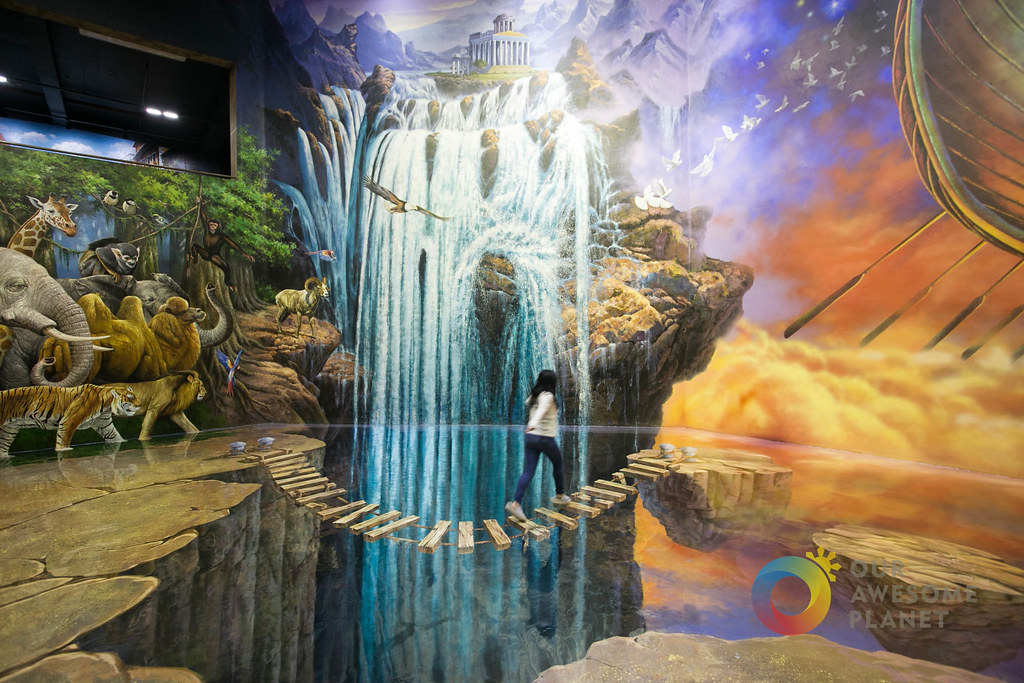Named after Manuel L. Quezon, the second President of the Philippines, Quezon stands today as a metropolitan area full of entertainment, shopping, art, business, and nightlife.
When making your plans to visit, take into account that dry season is from November to April, with typhoons sweeping through during the rainy season from May to October.
Let’s explore the best things to do in Quezon City:
Art in Island
You’ve seen those Facebook photos of people posing with life-size art pieces that seem to transport them into the photo, right? Well, now it’s your turn.
 At Art in Island in Quezon, you can help make each piece of art come to life with you as the star. These 3D paintings and photos swallow you whole and trick the camera into thinking that you are really riding a wild chariot of wild horses, that you are part of Santa’s reindeer troop, that you’re riding on Aladdin’s magic carpet, or that you are about to get your head bitten off by a ferocious lion.
At Art in Island in Quezon, you can help make each piece of art come to life with you as the star. These 3D paintings and photos swallow you whole and trick the camera into thinking that you are really riding a wild chariot of wild horses, that you are part of Santa’s reindeer troop, that you’re riding on Aladdin’s magic carpet, or that you are about to get your head bitten off by a ferocious lion.
La Mesa Eco Park
When you think Quezon, you certainly don’t think of lush jungle with greenery and wildlife- but it exists! At La Mesa Eco Park in Quezon, you can take a break from city life and transport to the tropical life.
 For only Php 20, you can enter the park and explore as long as you’d like by foot or by bringing your own bike. There is a koi pond full of colorful fish, a Butterfly Haven, an Orchidarium, a archery station, a swimming pool, a water bike, flower terrace, and even a spot for fishing.
For only Php 20, you can enter the park and explore as long as you’d like by foot or by bringing your own bike. There is a koi pond full of colorful fish, a Butterfly Haven, an Orchidarium, a archery station, a swimming pool, a water bike, flower terrace, and even a spot for fishing.
You could easily spend all day here and still not have experienced all of the beauty this park has to offer.
Lucena Cathedral
Lucena Cathedral is one of Quezon’s iconic landmarks. The original church was constructed in 1884. However, the church was rebuilt because the first structure was destroyed by fire in May 1887.
Lucena Cathedral remains to be one of the oldest churches in the province. It is the seat of the Bishop of Lucena. The cathedral’s official name is Saint Ferdinand Cathedral Parish, and its patron saint is Saint Ferdinand III. He is a 13th-century monk from Castile.
 Although it has experienced many renovations, Lucena Cathedral has maintained its colonial look and charm. Its most striking features include its high vaulted ceiling and magnificent altar, which features a large replica of Jesus Christ on the cross.
Although it has experienced many renovations, Lucena Cathedral has maintained its colonial look and charm. Its most striking features include its high vaulted ceiling and magnificent altar, which features a large replica of Jesus Christ on the cross.
The cathedral is a well-loved structure in Lucena and a symbol of the locals’ devotion to the Catholic religion. The cathedral hosts daily masses but Sundays are especially busy as more families go to the church and pray as part of their Sunday routine. Because of its central location, locals love to use the church as a meeting place.
During your visit, take the opportunity to go inside the church and admire its well-preserved architecture. You can also walk around the exterior grounds and witness how the locals go about their daily lives in the busiest section of the city.
Lucena Cathedral stands in Barangay Poblacion in the central area of Lucena City. It is right along Quezon Avenue.
Alibijaban Island
Alibijaban Island sits off the coast of Quezon’s Bondoc Peninsula and spans more than 400 hectares. The island has become a popular tourist destination in Quezon mainly because of its white beaches, coral reefs, and mangrove forest.
The mangrove forest occupies the central and central sections of the island. This area, which covers 225 hectares, is protected by law and is officially named Alibijaban Island Wilderness Area. This wilderness is home to several mangrove species and bird species. This is an excellent area to explore and do bird-watching.
 The surrounding waters of Alibijaban Island are teeming with marine life. This area is a protected marine sanctuary and is an amazing place to explore. If you want to snorkel here, don’t forget to bring your gear to the island.
The surrounding waters of Alibijaban Island are teeming with marine life. This area is a protected marine sanctuary and is an amazing place to explore. If you want to snorkel here, don’t forget to bring your gear to the island.
The main accommodation options on the island are homestays and small resorts with nipa huts. It’s also possible to camp on the beach if you bring a tent along. Day trippers to the Alibijaban can also rent open cottages.
The municipality of San Andres Quezon is the main jumping point to the island. To reach Alibijaban, you need to ride a boat from the port of San Andres. San Andres is about 330 kilometers from Manila and can be reached via the Pan-Philippine Highway and Bondoc Peninsula Road.
According to thecrazytourist.com, guidetothephilippines.ph














